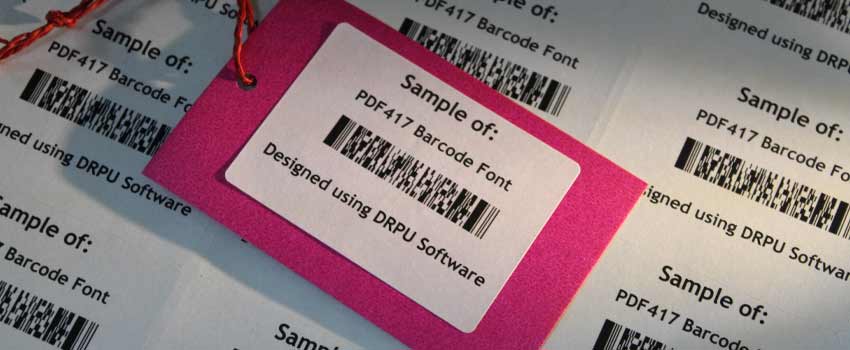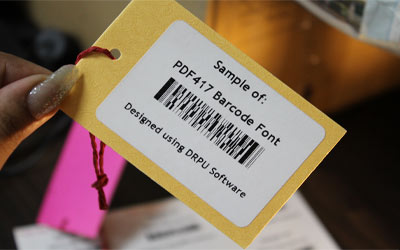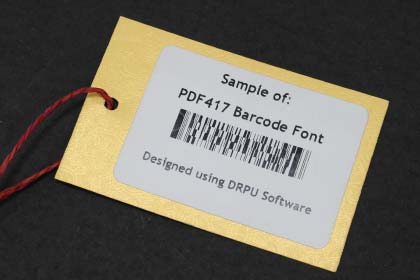Overview of PDF417 Barcode
The PDF417 barcode is a stacked linear barcode, which means that it is made up of multiple rows of linear barcode data stacked on top of one another. This allows for a higher data density than traditional linear barcodes, which are limited to a single row of data. The PDF417 barcode is also capable of storing both alphanumeric and binary data, making it a versatile option for a wide range of applications.
🞛 The PDF417 barcode is often used in applications where a large amount of data needs to be stored and retrieved quickly and efficiently. It is commonly used in the transportation industry for tracking packages and shipping information, as well as in healthcare for storing patient information on medical records and prescriptions. Other common uses of PDF417 barcodes include inventory management, ticketing systems, and ID card systems.
🞛 One of the key advantages of the PDF417 barcode is its ability to encode a large amount of data in a small space. Each barcode symbol can store up to 3,000 characters of data, which is much more than traditional linear barcodes can handle. This makes the PDF417 barcode a great option for applications that require the storage of long strings of data, such as addresses, product descriptions, or serial numbers.
🞛 Another advantage of the PDF417 barcode is its ability to encode both alphanumeric and binary data. This means that it can be used to store not only text and numbers, but also images, audio files, and other types of data. This versatility makes the PDF417 barcode useful in a wide range of applications, from tracking inventory in a warehouse to storing patient data in a hospital.
🞛 The PDF417 barcode also has a high level of error correction, which means that it can still be read even if part of the barcode is damaged or obscured. This is especially important in applications where the barcode may be exposed to harsh environmental conditions or rough handling, such as in shipping and logistics.
Advantages Of Using PDF417 Barcode
PDF417 barcodes offer several advantages over other types of barcodes:
-
Versatility:
PDF417 barcodes can be used in a wide range of applications, from inventory tracking and logistics to healthcare and government. This versatility makes them a popular choice for many different industries and use cases.
-
High Capacity:
PDF417 barcodes can hold much more data than traditional linear barcodes. They can store up to 1.1 kilobytes of data in a single symbol, making them ideal for applications that require a large amount of data to be encoded.
-
Flexibility:
:
PDF417 barcodes can be printed in a wide variety of sizes and shapes, and can be read from any angle. This makes them ideal for applications where space is limited or where the barcode needs to be read in a non-traditional orientation.
-
Security:
PDF417 barcodes can be encrypted to provide additional security for sensitive data. This makes them ideal for applications that require secure data transmission, such as in government or military settings.
-
Efficiency:
Because PDF417 barcodes can store a large amount of data in a single symbol, they can be used to streamline business processes and reduce the need for manual data entry. This can result in significant time and cost savings for businesses.
-
Compatibility:
PDF417 barcodes are widely supported by barcode scanning technology, making them compatible with a wide range of hardware and software systems. This makes them easy to implement in a variety of applications.
-
Error Correction:
PDF417 barcodes have built-in error correction capabilities, which means that even if a portion of the code is damaged or obscured, the barcode can still be read. This makes PDF417 barcodes more reliable than other types of barcodes, which may be unreadable if they become damaged.
Overall, the high capacity, error correction capabilities, flexibility, security, efficiency, compatibility, and versatility of PDF417 barcodes make them a valuable tool for businesses and organizations that need to encode and transmit large amounts of data in a reliable and efficient manner.
Types Of Characters can be Encoded PDF417 Barcode
PDF417 barcodes can encode a wide range of character sets, including alphanumeric characters, symbols, and control codes. The barcode uses a set of code words to represent different characters, with each code word representing a combination of bits that uniquely identify a specific character.

The PDF417 specification defines several different modes of encoding, each of which is optimized for a specific type of character set. The different modes include:
1Text Mode: This mode is designed to encode alphanumeric characters and a limited set of punctuation marks. In text mode, each code word represents two characters from a predefined set of 27 letters, 10 numbers, and 4 punctuation marks.
2 Numeric Mode: This mode is optimized for encoding numeric data. In numeric mode, each code word represents three digits from 0 to 9.
3Byte Mode: This mode is used to encode binary data, such as images, audio files, and other types of binary data. In byte mode, each code word represents a single byte of data, with a maximum of 6,928 bytes per barcode.
4 Byte Compaction Mode: This mode is similar to byte mode but is designed to optimize the encoding of data with a high percentage of ASCII characters. In byte compaction mode, each code word represents two or three ASCII characters.
5Mixed Mode: This mode combines text, numeric, and byte modes to enable the encoding of complex data sets. In mixed mode, each code word can represent different types of characters, depending on the data being encoded.
Conclusion: The ability to encode different types of characters in PDF417 barcodes makes them a versatile solution for a wide range of applications, from tracking and inventory management to document management and ticketing systems.
Data Encoded in PDF417 Barcode
PDF417 barcodes use a two-dimensional stacked symbology to encode data. The barcode consists of a series of stacked rows, each of which contains a certain number of columns. Each column consists of four bars and four spaces, with the width of each bar and space being determined by the module width of the barcode. The module width is the smallest unit of measurement used in the barcode, and it is determined by the resolution of the printing or scanning device.
To read a PDF417 barcode, a specialized barcode scanner is required. The scanner reads the barcode by shining a laser or LED light onto it and measuring the reflected light. The scanner then converts the reflected light into digital data, which is interpreted by a computer or other device. Because of its ability to store a large amount of data and its versatility in encoding different types of information, the PDF417 barcode is widely used in a variety of industries.
Text codewords are used to encode ASCII characters, such as letters and numbers. These codewords can represent up to two characters each. Byte codewords are used to encode binary data, such as images or other non-textual data. These codewords can represent up to one byte of data each. Numeric codewords are used to encode numeric data, such as telephone numbers or social security numbers. These codewords can represent up to three digits each.
The data encoding process for PDF417 barcodes is complex and can be customized to suit the needs of the user. The barcode can be encoded with a wide range of data types, including alphanumeric data, binary data, and text. The series of codewords, which are groups of bars and spaces that represent a specific value.
The encoding process starts with the data being divided into groups of up to 928 bytes. Each group of data is then encoded into a series of codewords using a combination of three types of codewords: text, byte, and numeric. The type of codeword used for each group of data depends on the type of data being encoded.
Once the data has been encoded into codewords, the codewords are then arranged into a series of rows and columns to form the final barcode. Each row contains a fixed number of codewords, and the number of rows in the barcode is determined by the amount of data that needs to be encoded the barcode scanner.
Conclusion: Overall, the data encoding process for PDF417 barcodes is complex but flexible, allowing for a wide range of data types to be encoded and customized to suit the needs of the user.
Disadvantages Of Using PDF417 Barcode

PDF417 barcodes have many advantages, including their ability to store large amounts of data in a compact format and their ability to encode different types of data. However, there are also some disadvantages to using PDF417 barcodes that are worth considering. In this response, we will discuss some of these disadvantages in detail.
-
Limited
Compatibility with Some Scanners:
While PDF417 barcodes can be read by many scanners, some older models may not be compatible. This can be an issue in industries where older equipment is still in use, or where different types of scanners are used by different parties in a supply chain.
-
More Sensitive to Printing Quality:
PDF417 barcodes can be more sensitive to printing quality than other barcode types, such as Code 39 or UPC. This is because PDF417 barcodes have more information encoded in them and require more precise printing. If the printing quality is poor or the contrast between the barcode and the background is insufficient, the barcode may not be readable by a scanner.
-
Higher Cost:
The increased complexity of PDF417 barcodes means that they can be more expensive to produce than other types of barcodes. This can be a consideration for businesses that need to produce large quantities of barcodes or have limited resources.
-
Limited Use in
Consumer Applications:
While PDF417 barcodes are widely used in industrial applications, they are not as commonly used in consumer applications. This can limit their utility in applications where consumers are expected to scan the barcodes themselves, such as mobile ticketing or loyalty programs.
-
Limited Scanning
Distance:
The maximum scanning distance for a PDF417 barcode is limited by the resolution of the scanner being used. This can be a disadvantage in situations where scanning distances may be variable or where barcodes need to be scanned from a distance.
-
More Complex to Generate:
Generating a PDF417 barcode requires specialized software and technical knowledge. This can make it more difficult for businesses to create their own barcodes or to work with third-party barcode providers.
-
Vulnerable to Damage:
Like all barcodes, PDF417 barcodes are vulnerable to damage from scratches, smudges, and other forms of wear and tear. However, because PDF417 barcodes contain more information than other types of barcodes, they may be more vulnerable to damage that affects the barcode's legibility.
-
Limited in Compatibility with Legacy Systems:
PDF417 barcodes may not be compatible with older or legacy systems, which can make it difficult to integrate them into existing workflows or supply chains.
Summary While PDF417 barcodes have many advantages, there are also some disadvantages that should be taken into account when considering their use. These include limited compatibility with some scanners, higher cost, limited use in consumer applications, limited scanning distance, vulnerability to damage, and limited compatibility with legacy systems. However, these disadvantages can often be mitigated through careful planning, proper printing and handling of the barcodes, and selecting the appropriate barcode format for the specific application.
